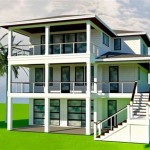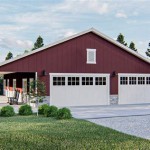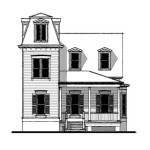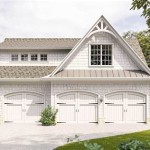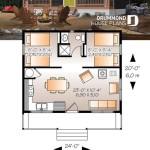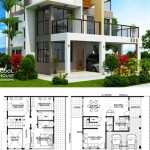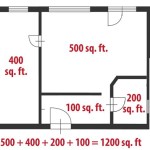House Plans With In-Law Suite On First Floor: A Comprehensive Guide
The concept of shared living is experiencing a resurgence. This trend is driven by factors such as rising housing costs, the desire to provide care for aging parents, and the multi-generational family dynamic becoming increasingly common. Consequently, house plans with in-law suites, particularly those located on the first floor, are gaining significant popularity. This article provides a detailed examination of the considerations, benefits, and design elements associated with these types of house plans.
Understanding the Appeal of First-Floor In-Law Suites
The primary advantage of locating an in-law suite on the first floor is accessibility. This is especially crucial for elderly relatives or individuals with mobility challenges. Stairs can present a significant obstacle for these individuals, making a first-floor suite a safer and more comfortable living environment. Further, having the suite on the same level as the main living areas facilitates easier interaction and supervision, promoting a sense of connection and security.
Beyond accessibility, a first-floor in-law suite offers a degree of privacy and independence for both the occupants of the suite and the primary residents of the house. While integrated into the main structure, the suite typically includes its own entrance, living area, bedroom, bathroom, and often a kitchenette. This separation allows for independent living without compromising the proximity required for care and support.
From a resale perspective, homes with first-floor in-law suites can be highly attractive to a broader range of potential buyers. Even if a future owner does not require the suite for an elderly relative, it can serve as a guest suite, a home office, a rental unit (where permitted by local zoning regulations), or a space for a live-in caregiver. This versatility adds value and broadens the market appeal of the property.
Key Design Considerations for First-Floor In-Law Suites
Designing a functional and comfortable first-floor in-law suite requires careful consideration of several key factors. These considerations extend beyond simply adding a room with a bathroom; they encompass the overall layout, accessibility features, and integration with the existing house design.
Accessibility: As mentioned previously, accessibility is paramount. This extends beyond simply avoiding stairs. Doorways should be wide enough to accommodate wheelchairs or walkers. Bathrooms should include grab bars, roll-in showers, and comfort-height toilets. The layout should be designed to minimize the risk of falls, with clear pathways and adequate lighting. Lever-style door handles are also easier to operate for individuals with limited dexterity.
Privacy and Soundproofing: While proximity is desirable, maintaining privacy is equally important. Soundproofing measures can significantly enhance the comfort of both parties. This can include installing insulation in the walls and floors separating the suite from the main house, using solid-core doors, and employing sound-dampening materials in the flooring. Strategically placing the suite away from high-traffic areas of the main house can also contribute to a more peaceful environment. A separate entrance is almost essential, allowing occupants to come and go without disturbing the main household.
Integration and Separation: The design should strike a balance between integration and separation. While the suite should be seamlessly integrated into the overall architectural style of the house, it should also maintain a degree of autonomy. A kitchenette, even a small one, can provide a significant level of independence, allowing occupants to prepare their own meals and snacks. A separate thermostat for the suite allows for individual temperature control, enhancing comfort. Connecting the suite to the main house's utilities is cost-effective, but ensuring adequate capacity and separately metered options (where possible and desirable) can be beneficial for long-term flexibility.
Natural Light and Ventilation: Adequate natural light and ventilation are crucial for creating a comfortable and inviting living space. Windows should be strategically placed to maximize natural light while maintaining privacy. Cross-ventilation can improve air quality and reduce the need for air conditioning. In addition, consider incorporating features such as skylights or sun tunnels to bring natural light into areas that may not have direct access to windows.
Safety Features: Safety is a critical consideration, particularly for elderly occupants. Smoke detectors and carbon monoxide detectors should be installed and regularly checked. Emergency call systems can provide an added layer of security, allowing occupants to easily summon help in case of a fall or other emergency. Non-slip flooring is essential in bathrooms and kitchens to minimize the risk of accidents. Illuminated light switches and nightlights can enhance visibility and reduce the risk of nighttime falls.
Exploring Different House Plan Styles with First-Floor In-Law Suites
First-floor in-law suites can be incorporated into a wide variety of house plan styles. The design should complement the overall architectural style of the house while meeting the specific needs of the occupants. Several factors, including lot size, budget, and personal preferences, will influence the selection of a suitable house plan.
Ranch-Style Homes: Ranch-style homes are particularly well-suited for first-floor in-law suites due to their single-story design. This eliminates the need for stairs, making the suite highly accessible. The layout of a ranch-style home can be easily adapted to incorporate a separate suite with its own entrance and amenities. The suite can be integrated into one end of the house, providing a clear separation from the main living areas.
Two-Story Homes: Two-story homes can also accommodate first-floor in-law suites, although careful planning is required to ensure accessibility and privacy. The suite is typically located on the ground floor, often at the rear of the house or to one side. A separate entrance can be created to provide independent access. Soundproofing measures are especially important in two-story homes to minimize noise transmission between the suite and the upper floors. A potential challenge is integrating the suite aesthetically with the existing facade of the home.
Cape Cod Homes: Cape Cod homes, with their characteristic gabled roofs and dormer windows, can also be adapted to include first-floor in-law suites. The suite is typically located on the ground floor, often extending out from the back of the house. The design should complement the traditional Cape Cod style, with features such as clapboard siding and shaker-style windows. The challenge is often maximizing the usable space within the suite while maintaining the architectural integrity of the house. Due diligence is required to ensure adequate ceiling height and room dimensions comply with building codes and accessibility standards.
Custom-Designed Homes: For those seeking a truly personalized solution, custom-designed homes offer the greatest flexibility in incorporating a first-floor in-law suite. A custom design allows for tailoring the suite to the specific needs and preferences of the occupants, ensuring optimal accessibility, privacy, and comfort. This option requires working closely with an architect or designer to develop a plan that meets all requirements and budget constraints. The advantage is complete control over every aspect of the design, from the layout and amenities to the materials and finishes.
Financial and Legal Considerations
Adding an in-law suite to a home involves significant financial and legal considerations. It is essential to carefully assess these factors before embarking on the project to avoid potential complications and ensure compliance with all applicable regulations.
Cost Analysis: The cost of adding an in-law suite can vary widely depending on the size, complexity, and features of the suite. Factors such as the location of the house, the availability of skilled labor, and the cost of materials will also influence the overall cost. It is essential to obtain detailed cost estimates from multiple contractors and to factor in contingency funds to cover unexpected expenses. Consider the long-term benefits of adding the suite, such as increased property value and reduced living expenses, when evaluating the financial feasibility of the project. Financing options may include home equity loans, personal loans, or government grants.
Zoning Regulations: Local zoning regulations may restrict or prohibit the construction of in-law suites or accessory dwelling units (ADUs). It is essential to thoroughly research the zoning regulations in your area before starting the project. Some jurisdictions may require special permits or approvals for in-law suites, while others may have restrictions on the size, location, or occupancy of the suite. Failure to comply with zoning regulations can result in fines, legal action, or even the requirement to remove the suite.
Building Codes: The construction of an in-law suite must comply with all applicable building codes, which are designed to ensure the safety and structural integrity of the building. Building codes typically address aspects such as fire safety, electrical wiring, plumbing, and ventilation. It is essential to obtain the necessary building permits and to have the construction inspected by a qualified building inspector to ensure compliance with all codes. Failure to comply with building codes can result in safety hazards and legal liabilities.
Property Taxes and Insurance: Adding an in-law suite may increase property taxes and insurance premiums. The assessed value of the property may increase due to the addition of the suite, resulting in higher property taxes. Insurance premiums may also increase to reflect the increased value of the property and the potential for additional liability. It is essential to consult with a tax advisor and an insurance agent to assess the potential impact on property taxes and insurance premiums.
Rental Considerations: If the in-law suite is intended to be rented out, it is essential to comply with all applicable rental laws and regulations. This may include obtaining a rental license, complying with fair housing laws, and providing tenants with a safe and habitable dwelling. A written lease agreement should be prepared to outline the terms and conditions of the rental arrangement, including rent, security deposit, and responsibilities of both landlord and tenant. Consult with a legal professional to ensure compliance with all applicable rental laws.
One Story Layout With In Law Apartment Builder

In Law Suite Plans Give Mom Space And Keep Yours The House Designers

House Plans With In Law Suite Floor Designs

Modern Farmhouse Plan With In Law Suite 70607mk Architectural Designs House Plans

6 Bedroom Country Style Home With In Law Suite The Plan Collection

House Plans With In Law Suites Houseplans Blog Com

Inlaw Suite House Plans With Detached Mother In Law Fresh New Bungalow Brick

House Plans With In Law Suites Houseplans Blog Com

5 Bedroom Ranch House Plan With In Law Suite 2875 Sq Ft

One Story With In Law Suite Plan 2286
Related Posts

